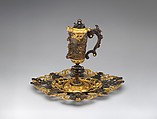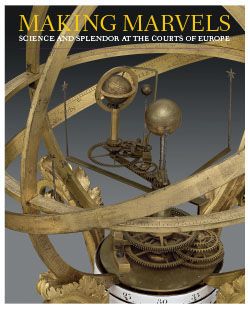Ewer and stand (présentoir)
Martin Gizl Austrian
The hunting of the alpine ibex, a wild goat species endangered as early as the eighteenth century, was restricted to the court of the prince-archbishops of Salzburg. Accordingly, the iconographic decoration of objects incorporating the material tends to be dominated by dramatic hunting scenes that present the hunt as a feudal right and a premier courtly entertainment. The manipulation of this delicate material represented man’s conquest over nature, a principle that originated from the humanist thinking of the Renaissance. Exuberant works of art made from ibex horn were sent to foreign courts as diplomatic gifts. This ensemble also refers to ibex horn in a pharmaceutical context: it allegedly possessed the ability to prevent poisoning and evil, as well as having aphrodisiac properties and an intrinsic value worth its weight in gold (see also cats. 20, 31). The entry on the animal published in 1744 in Johann Heinrich Zedler’s Universal-Lexicon notes, “Spoons, small bowls, or drinking vessels made out of ibex are incomparably healthy against poison and epilepsy [fallende Sucht].” [1]
Two large rococo altar candlesticks mounted in gilded copper in the Cathedral Museum of Salzburg may have originally formed a set with this ewer and basin.[2] The patron of the ensemble, Count Philipp Carl von Seinsheim, was a nephew of four bishops of the Schönborn family, the major art patrons of Franconia and the Rhineland in the eighteenth century. The ensemble’s commanding originality of design is evident in the sophisticated play between the texture of the costly natural material and the light-catching sheen of the precious metals, the combination of whimsical sculptural details, and the flawless incorporation of a broad ornamental vocabulary of asymmetrical rocaille formations and pure gold inserts. The object encapsulates how apotropaic materials could be transformed into works that, through great skill and considerable imagination, honor them artistically. No known ibex carving is comparably ambitious in its level of artistry and craftsmanship.
In the eighteenth century, the town of Salzburg was the capital of an independent ecclesiastical state ruled by a prince-archbishop, the Primas Germaniae, who was the highest-ranking Catholic “defender of the faith” north of the Alps. Salzburg artisans may have been inspired by Chinese rhinoceros-horn vessels to use sought-after local materials to carve and turn equally “exotic” substances in fanciful interpretations of the Chinese style (see the essay by Paulus Rainer in this volume).[3] The ibex horn in this piece was thus elevated, through Martin Gizl’s attention to its symbolism and beauty, to the same level as naturalia from distant lands. In courtly and ecclesiastical ceremonies, the use of these highly valuable, extravagantly worked “natural products” proclaimed princely magnificentia.[4]
Footnotes
(For key to shortened references see bibliography in Koeppe, Making Marvels: Science & Splendor at the Courts of Europe: The Metropolitan Museum of Art, 2019)
1. “Ein Löffel, Näpflein, oder Trinkgeschirr, so aus dergleichen Horne gemacht, ist unvergleichlich gesund wider den Gift und die fallende Sucht.” Zedler 1732–54, vol. 39 (1744), s.v. “Steinbock,” col. 1636, no. 12. See also Himmelein 2015, p. 41.
2. Watteck 1975, p. 13, ill. no. 10.
3. Watteck 1962, p. 29, figs. 5–7; compare a group of rhinoceros-horn cups in the Metropolitan Museum (MMA 08.212.1–.11).
4. Watteck 1962; Gumppenberg 1984, p. 287; Koeppe 2004, pp. 82–83.
Due to rights restrictions, this image cannot be enlarged, viewed at full screen, or downloaded.




